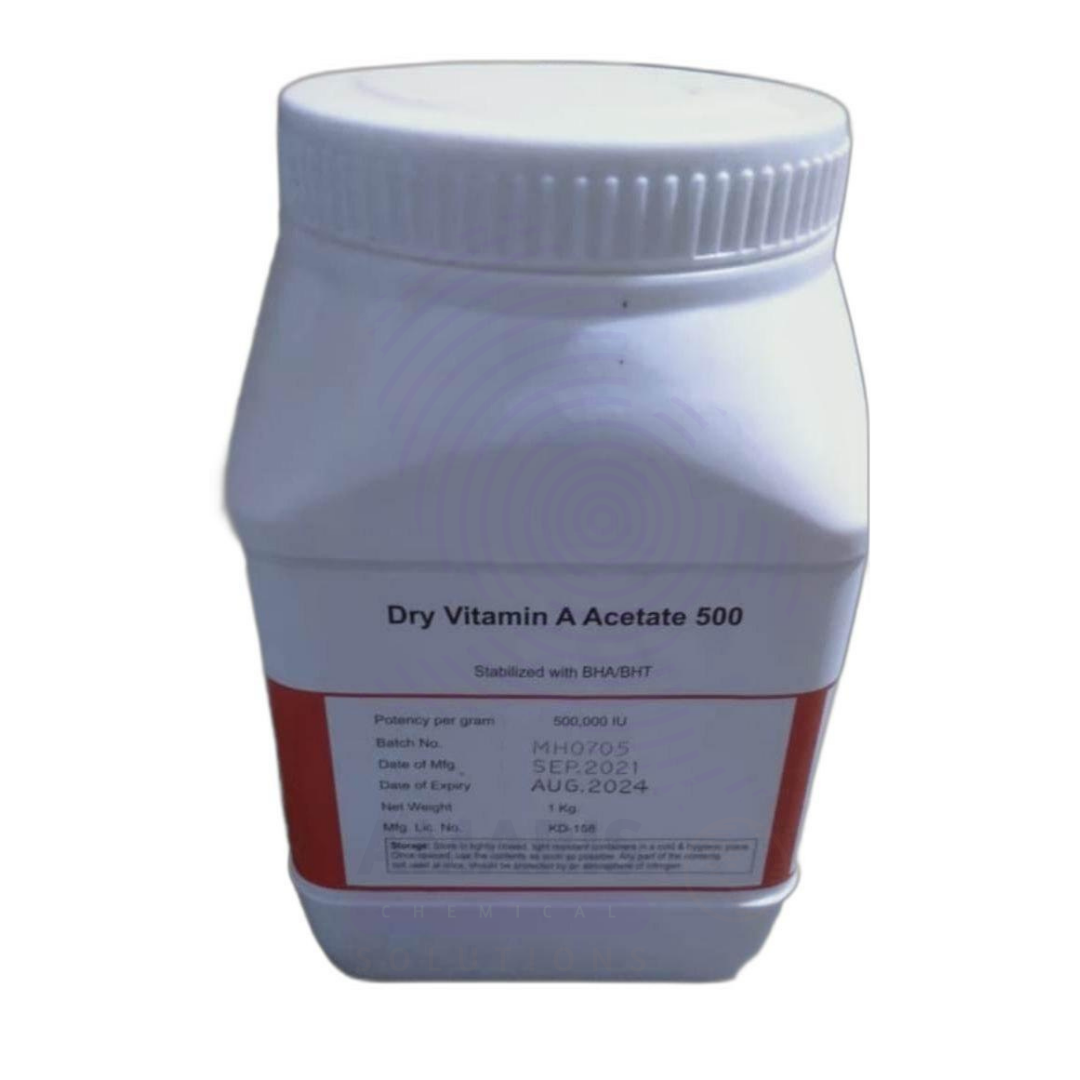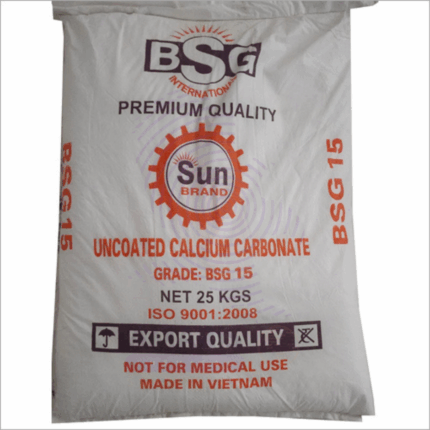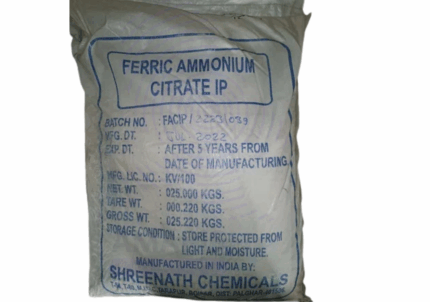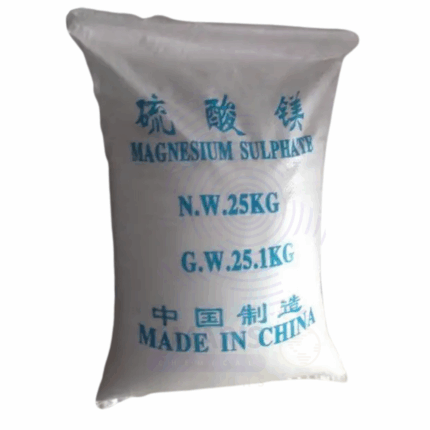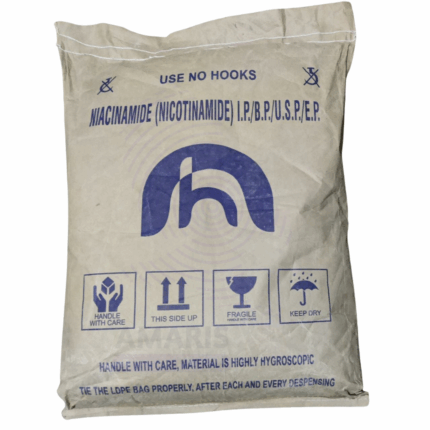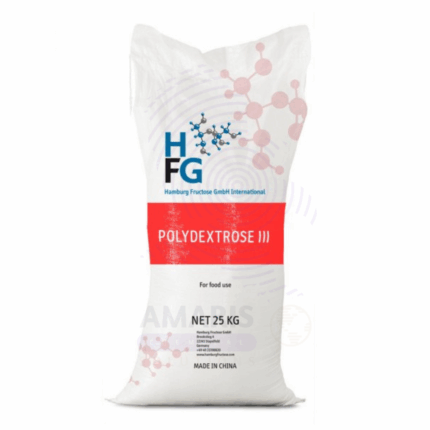
Semi Circle Glass Block
$ 15.89 Original price was: $ 15.89.$ 15.76Current price is: $ 15.76.
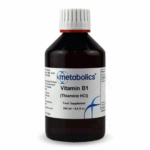
Vitamin B1 Thiamine HCL Extra Pure
$ 16.21 Original price was: $ 16.21.$ 16.09Current price is: $ 16.09.
Vitamin A Acetate powder
$ 17.45 Original price was: $ 17.45.$ 17.34Current price is: $ 17.34.
Whatsapp Order
Vitamin A Acetate Powder is a pale yellow, fine powder used as a stable form of vitamin A in nutritional supplements, pharmaceuticals, and cosmetic formulations. It is essential for vision, immune function, and skin health. The Extra Pure grade ensures high potency and minimal impurities, suitable for analytical and formulation purposes. Due to its sensitivity to light and air, it requires careful storage and handling to maintain stability and effectiveness.
Description
Table of Contents
Toggle
Vitamin A Acetate powder
Primary Uses
- Analytical Reagent & Laboratory Applications
- Used as a reference standard in vitamin A quantification assays such as HPLC and spectrophotometry
- Essential in biochemical and molecular biology research to study vitamin A metabolism, retinoid signaling, and gene expression
- Utilized in formulation development, quality control, and stability testing of vitamin A supplements and pharmaceuticals
- Applied in cell culture media to investigate vitamin A’s role in cell differentiation and proliferation
- Pharmaceutical & Cosmetic Industry
- Active ingredient in vitamin A dietary supplements to treat vitamin A deficiency and related disorders
- Incorporated in topical creams, serums, and ointments for skin care, anti-aging, acne treatment, and wound healing due to antioxidant properties
- Used in ophthalmic formulations supporting eye health and vision maintenance
- Included in veterinary pharmaceutical products for animal health and nutrition
Secondary Uses
- Food Industry (in regulated quantities)
- Fortificant in powdered foods, dairy substitutes, cereals, and infant formulas to enrich vitamin A content
- Added in animal feed to promote healthy growth and prevent deficiency diseases in livestock
- Used in dietary supplements such as capsules, tablets, and multivitamin complexes
- Cosmetic and Personal Care Industry
- Acts as an antioxidant and skin conditioning agent in lotions, creams, and sunscreens
- Helps improve skin texture, reduce fine lines and wrinkles, and promote epidermal regeneration
- Agricultural & Veterinary Applications
- Supplemented in animal nutrition to prevent conditions such as xerophthalmia and improve overall animal health
KEY PRODUCT FEATURES
1. Basic Identification Attributes
- Chemical Name: Vitamin A Acetate (Retinyl Acetate)
- CAS Number: 127-47-9
- HS Code: 2936.29.00
- Molecular Formula: C₂₂H₃₂O₂
- Synonyms: Retinyl Acetate, Vitamin A1 Acetate
2. Physical & Chemical Properties
- Physical State: Fine powder
- Color & Odor: Pale yellow to yellow, odorless or slight characteristic odor
- Melting Point: 120–130 °C
- Solubility: Insoluble in water; soluble in oils, fats, ethanol, chloroform
- Stability: Sensitive to light, heat, and oxygen; oxidizes easily
- pH Level: Not applicable (water insoluble)
3. Safety & Hazard Attributes
- Hazard Class (GHS Classification): Skin irritation (Category 2), Eye irritation (Category 2A)
- NFPA Ratings: Health: 1, Flammability: 1, Reactivity: 0
- Exposure Limits: No specific OSHA PEL or ACGIH TLV established
- Reactivity: Stable if protected from light, heat, and air
4. Storage & Handling Attributes
- Storage Conditions: Store in cool, dry, dark, and well-ventilated place
- Incompatible Materials: Strong oxidizing agents, prolonged exposure to heat and air
- Container Type: Sealed opaque containers or amber glass bottles
- Shelf Life & Expiration Date: Stable for 2–3 years if stored properly
- Special Handling Requirements: Use gloves, avoid dust inhalation, handle in well-ventilated areas
5. Regulatory & Compliance Attributes
- Regulatory Status: Approved for food, pharmaceutical, and cosmetic use by FDA and other authorities
- Transportation Restrictions: Not classified as hazardous for transport
6. Environmental & Health Impact
- Ecotoxicity: Low toxicity to aquatic organisms
- Persistence in Environment: Biodegradable under aerobic conditions
- Carcinogenicity/Mutagenicity: Not classified as carcinogenic or mutagenic
- Biodegradability: Biodegradable
SAFETY HANDLING PRECAUTIONS
Safety Handling Precautions
Personal Protective Equipment (PPE):
- Wear chemical-resistant gloves
- Use safety goggles
- Wear lab coat or protective clothing
- Use dust mask if dust is generated
Handling:
- Handle in a well-ventilated area
- Avoid skin and eye contact
- Do not inhale dust
- Wash hands thoroughly after handling
Storage:
- Store in tightly closed containers
- Keep in cool, dry, dark environment
- Avoid exposure to heat, light, and oxidizers
First Aid Measures
Inhalation:
- Move to fresh air
- Seek medical attention if breathing difficulty occurs
Skin Contact:
- Wash skin with soap and water
- Remove contaminated clothing
- Seek medical advice if irritation occurs
Eye Contact:
- Rinse immediately with water for at least 15 minutes
- Seek medical attention if irritation persists
Ingestion:
- Rinse mouth with water
- Do not induce vomiting unless advised
- Seek medical attention if symptoms occur
Fire Fighting Measures
Flammability:
- Combustible powder
Extinguishing Media:
- Use dry chemical, CO₂, foam, or water spray
Hazardous Combustion Products:
- May produce carbon monoxide, carbon dioxide, and other toxic fumes
Firefighter Protection:
- Wear self-contained breathing apparatus and full protective gear
Related products
Blueberry Toppings
Blueberry Toppings are sweet, fruit-based condiment preparations made primarily from blueberries, sugar, and thickening agents. They are characterized by a vibrant blue-purple color, fruity aroma, and a sweet-tart flavor profile. Typically semi-viscous with chunks or pureed pieces of blueberry, these toppings are used as finishing ingredients in desserts, breakfast foods, and beverages. Blueberry toppings may be prepared as preserves, syrups, or glazes and often contain natural flavors and preservatives to enhance shelf life and sensory appeal.
Calcium Carbonate Uncoated
Calcium Carbonate Uncoated is a naturally occurring mineral compound composed primarily of calcium, carbon, and oxygen with the chemical formula CaCO₃. It appears as a fine white powder or granules, widely used as a filler, pigment, and functional additive across various industries. The uncoated form means the calcium carbonate particles are not surface-treated, retaining their natural properties. It is valued for its high brightness, whiteness, and excellent compressibility. Uncoated calcium carbonate is used to enhance opacity, improve processing, and reduce costs in plastics, paints, coatings, adhesives, rubber, paper, and construction materials.
Ferric Ammonium Citrate
Ferric Ammonium Citrate is a dark green to black crystalline or granular inorganic compound composed of iron, ammonium ions, and citrate ions. It is a complex salt of citric acid with ferric iron (Fe³⁺) and ammonium. This compound is highly soluble in water, forming a greenish solution, and is widely utilized as a source of iron in various chemical, pharmaceutical, photographic, and food applications. It acts as a mild oxidizing agent and an iron supplement, valued for its bioavailability and ease of incorporation into formulations. Ferric Ammonium Citrate is typically available in different formulations distinguished by their water and ammonium content, such as green and brown types.
Magnesium Chloride Hexahydrate BP
Magnesium Chloride Hexahydrate BP is a pharmacopeial grade white crystalline solid with the chemical formula MgCl₂·6H₂O. It is highly soluble in water and is used extensively in pharmaceutical, medical, and industrial applications. This grade meets British Pharmacopoeia (BP) standards ensuring high purity and suitability for medical and food-related uses. Magnesium Chloride Hexahydrate BP provides essential magnesium ions which play a critical role in numerous physiological functions.
Magnesium Sulphate (Epsom Salt)
Magnesium Sulphate Epsom Salt, commonly known as Epsom Salt, is an inorganic salt composed of magnesium, sulfur, and oxygen with the formula MgSO₄. It typically appears as colorless or white crystalline granules and is highly soluble in water. In its heptahydrate form (MgSO₄·7H₂O), it is widely used in agriculture, pharmaceuticals, food, and industrial applications. Epsom Salt is valued for its muscle relaxant, laxative, and magnesium supplementation properties, as well as for its role in improving soil fertility and plant growth.
Manganese Sulphate Monohydrate
Manganese Sulphate Monohydrate is an inorganic chemical compound with the formula MnSO₄·H₂O. It appears as a pale pink crystalline powder and is highly soluble in water. It is primarily used as a source of manganese, an essential micronutrient, in fertilizers, animal feed, and industrial processes. This monohydrate form is the most stable and commonly used in agriculture and feed-grade applications. It also finds use in various chemical syntheses, electroplating, and as a reagent in laboratories.
Nicotinamide BP
Nicotinamide BP, also known as niacinamide, is a water-soluble form of vitamin B3 (niacin). It is a vital nutrient involved in numerous cellular processes, including energy metabolism, DNA repair, and antioxidant activity. Widely used in pharmaceutical, cosmetic, and nutritional applications, Nicotinamide supports skin health, improves barrier function, and exhibits anti-inflammatory properties. It is commonly found in dietary supplements, skincare formulations, and medical treatments for various dermatological conditions.
Polydextrose
Polydextrose is a synthetic, highly branched polymer of glucose used primarily as a soluble dietary fiber, bulking agent, and low-calorie sweetener. It is produced through the polycondensation of dextrose with sorbitol and citric acid. Polydextrose offers numerous health and functional benefits, such as improving texture, replacing sugar or fat, and supporting digestive health. It is extensively used in food, beverages, pharmaceuticals, and nutraceuticals for its fiber enrichment properties and technological versatility.


 Preservatives(food)
Preservatives(food) Flavor Enhancers
Flavor Enhancers Acidulants
Acidulants Sweeteners
Sweeteners Antioxidants
Antioxidants Colorants(food)
Colorants(food) Nutraceutical Ingredients (food)
Nutraceutical Ingredients (food) Nutrient Supplements
Nutrient Supplements Emulsifiers
Emulsifiers
 Collectors
Collectors Dust Suppressants
Dust Suppressants Explosives and Blasting Agents
Explosives and Blasting Agents Flocculants and Coagulants
Flocculants and Coagulants Frothers
Frothers Leaching Agents
Leaching Agents pH Modifiers
pH Modifiers Precious Metal Extraction Agents
Precious Metal Extraction Agents
 Antioxidants(plastic)
Antioxidants(plastic) Colorants (Pigments, Dyes)
Colorants (Pigments, Dyes) Fillers and Reinforcements
Fillers and Reinforcements Flame Retardants
Flame Retardants Monomers
Monomers Plasticizers
Plasticizers Polymerization Initiators
Polymerization Initiators Stabilizers (UV, Heat)
Stabilizers (UV, Heat)
 Antifoaming Agents
Antifoaming Agents Chelating Agents
Chelating Agents Coagulants and Flocculants
Coagulants and Flocculants Corrosion Inhibitors
Corrosion Inhibitors Disinfectants and Biocides
Disinfectants and Biocides Oxidizing Agents
Oxidizing Agents pH Adjusters
pH Adjusters Scale Inhibitors( water)
Scale Inhibitors( water)
 Antioxidants(cosmetic)
Antioxidants(cosmetic) Emollients
Emollients Fragrances and Essential Oils
Fragrances and Essential Oils Humectants
Humectants Preservatives
Preservatives Surfactants(cosmetic)
Surfactants(cosmetic) Thickeners
Thickeners UV Filters
UV Filters
 Fertilizers
Fertilizers Soil Conditioners
Soil Conditioners Plant Growth Regulators
Plant Growth Regulators Animal Feed Additives
Animal Feed Additives Biostimulants
Biostimulants Pesticides (Herbicides, Insecticides, Fungicides)
Pesticides (Herbicides, Insecticides, Fungicides)
 Active Pharmaceutical Ingredients (APIs)
Active Pharmaceutical Ingredients (APIs) Excipients
Excipients Solvents(pharmaceutical)
Solvents(pharmaceutical) Antibiotics
Antibiotics Antiseptics and Disinfectants
Antiseptics and Disinfectants Vaccine Adjuvants
Vaccine Adjuvants Nutraceutical Ingredients (pharmaceutical)
Nutraceutical Ingredients (pharmaceutical) Analgesics & Antipyretics
Analgesics & Antipyretics
 Analytical Reagents
Analytical Reagents Solvents(lab)
Solvents(lab) Chromatography Chemicals
Chromatography Chemicals Spectroscopy Reagents
Spectroscopy Reagents microbiology-and-cell-culture-reagents
microbiology-and-cell-culture-reagents Molecular Biology Reagents
Molecular Biology Reagents Biochemical Reagents
Biochemical Reagents Inorganic and Organic Standards
Inorganic and Organic Standards Laboratory Safety Chemicals
Laboratory Safety Chemicals Specialty Laboratory Chemicals(Special Laboratory Equipment)
Specialty Laboratory Chemicals(Special Laboratory Equipment)
 Demulsifiers
Demulsifiers Hydraulic Fracturing Fluids
Hydraulic Fracturing Fluids Scale Inhibitors(oil)
Scale Inhibitors(oil) Surfactants(oil)
Surfactants(oil) Drilling Fluids
Drilling Fluids
 Dyes and Pigments
Dyes and Pigments Bleaching Agents
Bleaching Agents Softening Agents
Softening Agents Finishing Agents
Finishing Agents Antistatic Agents
Antistatic Agents
 Admixtures
Admixtures Waterproofing Agents
Waterproofing Agents Sealants and Adhesives
Sealants and Adhesives Curing Compounds
Curing Compounds Concrete Repair Chemicals
Concrete Repair Chemicals Anti-Corrosion Coatings
Anti-Corrosion Coatings
 Surfactants(cleaning)
Surfactants(cleaning) Builders
Builders Enzymes
Enzymes Solvents (Cleaning)
Solvents (Cleaning) Fragrances
Fragrances
 Electronic Chemicals
Electronic Chemicals Catalysts
Catalysts Lubricants
Lubricants Photographic Chemicals
Photographic Chemicals Refrigerants
Refrigerants Automotive chemicals
Automotive chemicals Pyrotechnic Chemicals
Pyrotechnic Chemicals
 Biodegradable Surfactants
Biodegradable Surfactants Bio-based Solvents
Bio-based Solvents Renewable Polymers
Renewable Polymers Carbon Capture Chemicals
Carbon Capture Chemicals Wastewater Treatment Chemicals
Wastewater Treatment Chemicals
 Pigments
Pigments Solvents(paint)
Solvents(paint) Specialty Coatings
Specialty Coatings Binders/Resins
Binders/Resins Additives
Additives Driers
Driers Anti-Corrosion Agents
Anti-Corrosion Agents Functional Coatings
Functional Coatings Application-Specific Coatings
Application-Specific Coatings
 Fresh Herbs
Fresh Herbs Ground Spices
Ground Spices Whole Spices
Whole Spices Spice Blends
Spice Blends Dried Herbs
Dried Herbs
 Leavening Agents
Leavening Agents Dough Conditioners
Dough Conditioners Flour Treatments
Flour Treatments Fat Replacers
Fat Replacers Decoratives
Decoratives Preservatives(baking)
Preservatives(baking)
 Plasticizers & Softeners
Plasticizers & Softeners Reinforcing Agents
Reinforcing Agents Adhesion Promoters
Adhesion Promoters Vulcanizing Agents
Vulcanizing Agents Antidegradants
Antidegradants Blowing Agents
Blowing Agents Fillers & Extenders
Fillers & Extenders Accelerators & Retarders
Accelerators & Retarders